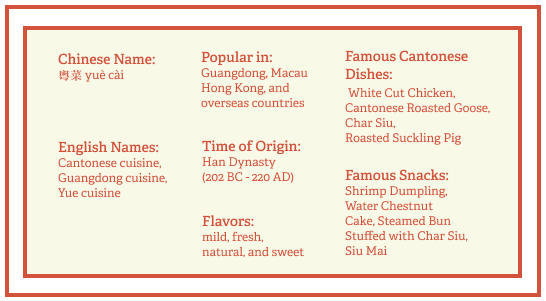
The Pearl River Delta area of Guangdong province, anchored by the city of Guangzhou, was the first region sanctioned by the Qing Dynasty imperial court to be opened for trade with the outside world in the 18th century. As foreign merchants arrived in the region, they established trading posts and brought along with them not only their merchandise, but their culinary customs as well. Thus Guangdong cooking became the first truly cosmopolitan cuisine of China. And as Guandgong residents were among the first in China to immigrate to America, their food has cemented itself as the default Chinese cooking in the States.
Cantonese or Yue cuisine originates from Guangdong Province (South East China around Hong Kong), and it is the most widely served style of Chinese cuisine in the world. This is because most of the Chinese who immigrated and set up restaurants overseas were from Guangdong. Though what's served abroad now has departed from authentic Yue cuisine.

Chefs at that time have been already good at cooking different materials by particular cooking methods. After the capital was moved from north to the south in Southern Song Dynasty (1127 - 1279 AD), many skillful chefs gathered in Guangzhou, contributing to the development of Cantonese cuisine and Cantonese cooking skills became mature and forms some of its own characteristics. In Ming Dynasty (1368 - 1644 AD) and Qing Dynasty (1644 - 1911 AD), Cantonese cuisine had become systematic and Guangzhou was full of tea houses, hotels, restaurants and snack shops.
In early 19 century, a number of Guangdong people went to North America, they ran many Cantonese cuisine restaurants and gradually Cantonese food became the most popular Chinese food around the world. Now, it is also the most popular Chinese cuisine overseas.
Unfortunately, Cantonese immigrants have been struggling to reproduce their native cuisine in a foreign land, resulting in the "pseudo-Chinese" cuisine we know today. Although these not-quite-authentic Chinese dishes may not be part of the ancient Chinese food culture, they are authentic products of the Chinese immigrant experience, yielding diverse takes on Chinese food tweaked for local palettes.
There is a stereotype in Chinese that Guangdong people eat everything and that is not groundless. Cantonese cuisine is famous for the rich food materials which include poultries, birds, sea food, woodland delicacies, various vegetables and fruits and often the best part of them are selected for cooking. Cantonese people prefer seasonal food. For instance, they eat perches in middle winter and shrimps in April when they are fattest and tasty. The rich seasonings are mild and mellow which contain aniseed, coriander leaves, rice vinegar, oyster sauce, hoisin sauce, honey and sugar.
Cantonese cuisine is considered the "haute cuisine" of China. The Cantonese are very fortunate to live in an area with such abundant rainfall and a warm tropical climate. Guangdong Province is known for its agriculture, and there are plenty of pig and poultry farms in the area. Lush rice paddies are scattered all throughout the Pearl River Delta.
Located on the Pearl River, Guangdong province's capital Guangzhou makes an excellent seaport through which many foreign ingredients are imported from other countries. Inventive as the Cantonese are, they are happy to incorporate these non-native ingredients into their cuisine.
The hallmark of Cantonese cuisine is preserving the natural flavors of the food.
Most Cantonese food tastes fresh, natural, and mild. A Cantonese cook knows fresh is best, and pays attention to the quality and natural taste of food materials. Cantonese chefs are very cautious about seasonings, they go all the way to make sure your meal isn't overcooked or too heavily seasoned. The seasonings are to bring out or highlight the original taste of the ingredient, not to make it. However, no Cantonese kitchen
would be complete without a bottle of oyster sauce and hoisin sauce. Spices such as ginger, chives, black pepper, and anise also figure prominently in Cantonese cooking. Less spicy ingredients such as peppers, chili, ginger and garlic are used. With the seasonal changes, dishes in summer and autumn are light, in winter and spring are a little bit heavier. Amongst the varied cooking techniques, steaming and braising are a Cantonese cook's favorite.
Unlike overseas Chinese food and some regional styles, a lot of oil or grease isn't used either. Neither are dairy products. So unlike creamy cheese wontons or a sweet and sour pork on rice meal deal at a Chinese fast food restaurant overseas, there are not a lot of calories in the dishes. This combined with the white rice or rice noodles that is the staple and the dim sum made with little or no sugar may leave a foreigner feeling hungry.